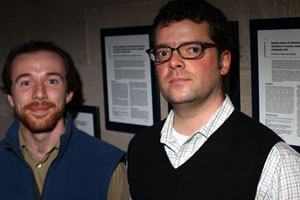 |
| Graduate students Coilin Minto and Daniel Ricard initiated the stairwell tribute to Ransom Myers. (Bruce Bottomley Photo) |
On the day that friends and colleagues heard that Ransom Myers died, the front pages of the many papers he had authored and co-authored over a prolific career appeared along the stairwell of the LSC’s biology wing.
It was the stairwell Dr. Myers would bounce up each morning, greeting students along the way, sloshing coffee from a china mug, conversing with his lab mates and reading a scientific paper — usually all at the same time. Dr. Myers, who died in 2007 of a brain tumor at the age of 54, was known for his boundless energy, passion and curiosity.
The spontaneous tribute was the work of two graduate students: Daniel Ricard and Coilin Minto. Now their effort has been made into a permanent memorial for a brilliant scientist and former head of what’s affectionately referred to as the “RAMpire.” (Dr. Myers was often called by his initials, RAM.)
At a lunchtime event on March 31, more than 50 people assembled in the biology wing and walked up the stairwell together—past “Phototaxis and cannibalism in gammaridean amphipods” and “Hooded seal (Cystophora cristata) pup production in the Gulf of St. Lawrence” and all the way up to “Saving endangered whales at no cost.” Starting off with a photo of Dr. Myers nose-to-nose with a gigantic leatherback turtle on the second floor, the tribute continues up to the eighth floor—a testament to his staggering output.
“How far would we get if we put a paper on each step?” said Mr. Ricard, explaining the genesis of the project. “We started taping.”
There are actually more papers—175—than steps. They include Dr. Myers’ landmark research papers on declining fish populations in the world’s oceans, published in such journals as Nature, Science, Ecology and the Canadian Journal of Fisheries and Aquatic Sciences.
“I didn’t know how they appeared,” explains Keith Taylor, former Dean of Science, of the initial tribute three years ago, “but the impact was massive. It’s a very unique memorial to a scientist.”
Within days of his death, there were more papers to add to the stairwell. On March 27, 2007, a study by Dr. Myers and Julia Baum was published in the journal Science reporting that the over-fishing of large predatory sharks was having a cascading effect throughout the food chain. There have been at least 15 other posthumous publications.
For the students, taping up those papers helped them mourn their mentor. “It left us with a humbling feeling of what we could do in our careers,” says Mr. Ricard.
Publishing was Dr. Myers’ way of getting his research out; they were calls to action, opening salvos in ongoing arguments. Mr. Ricard recalls asking Dr. Myers’ how he would respond to his critics—“all the tuna people I worked with were up in arms,” he informs. To which Dr. Myers responded, “Let them publish.”
